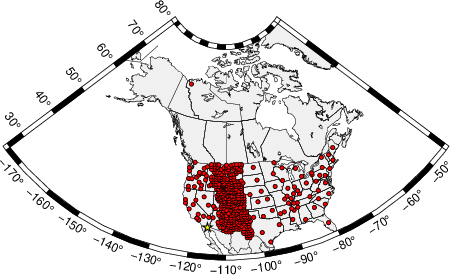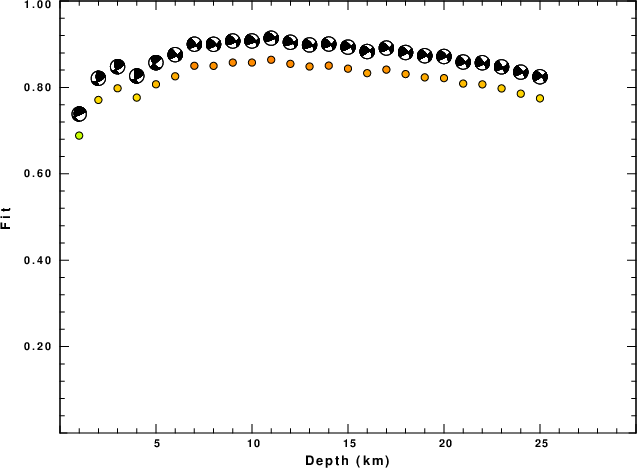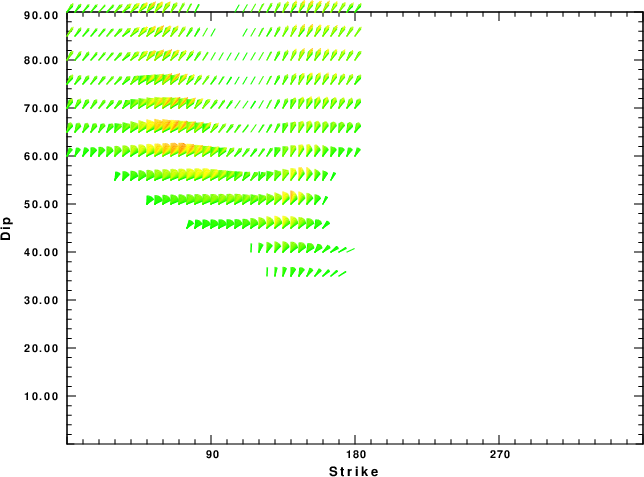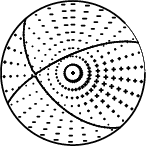Location
Location ANSS
The ANSS event ID is ci14404512 and the event page is at
https://earthquake.usgs.gov/earthquakes/eventpage/ci14404512/executive.
2008/11/20 19:23:01 32.329 -115.332 6.0 4.98 Baja California, Mexico
Focal Mechanism
USGS/SLU Moment Tensor Solution
ENS 2008/11/20 19:23:01:0 32.33 -115.33 6.0 5.0 Baja California, Mexico
Stations used:
CI.BAR CI.GLA CI.GSC CI.ISA CI.MWC CI.OSI CI.PASC II.PFO
IU.TUC LB.TPH TA.109C TA.113A TA.114A TA.116A TA.117A
TA.119A TA.120A TA.214A TA.217A TA.218A TA.220A TA.318A
TA.319A TA.U15A TA.U16A TA.U17A TA.V15A TA.V17A TA.V18A
TA.W13A TA.W16A TA.W18A TA.W19A TA.X16A TA.X17A TA.X18A
TA.X19A TA.Y12C TA.Y15A TA.Y16A TA.Y17A TA.Y18A TA.Y19A
TA.Z13A TA.Z14A TA.Z15A TA.Z17A TA.Z19A TA.Z20A US.WUAZ
UU.CCUT
Filtering commands used:
hp c 0.02 n 3
lp c 0.05 n 3
Best Fitting Double Couple
Mo = 1.19e+23 dyne-cm
Mw = 4.65
Z = 14 km
Plane Strike Dip Rake
NP1 145 76 159
NP2 240 70 15
Principal Axes:
Axis Value Plunge Azimuth
T 1.19e+23 24 101
N 0.00e+00 65 292
P -1.19e+23 4 193
Moment Tensor: (dyne-cm)
Component Value
Mxx -1.08e+23
Mxy -4.54e+22
Mxz -7.75e+20
Myy 8.85e+22
Myz 4.58e+22
Mzz 1.98e+22
--------------
----------------------
##--------------------------
####--------------------------
######----------------------------
########-----------------------#####
##########---------------#############
############---------###################
#############-----######################
###############-##########################
#############---##########################
###########------################## ####
#########----------################ T ####
######-------------############### ###
####----------------####################
##-------------------#################
----------------------##############
----------------------############
-----------------------#######
------------------------####
----- --------------
- P ----------
Global CMT Convention Moment Tensor:
R T P
1.98e+22 -7.75e+20 -4.58e+22
-7.75e+20 -1.08e+23 4.54e+22
-4.58e+22 4.54e+22 8.85e+22
Details of the solution is found at
http://www.eas.slu.edu/eqc/eqc_mt/MECH.NA/20081120192301/index.html
|
Preferred Solution
The preferred solution from an analysis of the surface-wave spectral amplitude radiation pattern, waveform inversion or first motion observations is
STK = 240
DIP = 70
RAKE = 15
MW = 4.65
HS = 14.0
The NDK file is 20081120192301.ndk
The waveform inversion is preferred.
Moment Tensor Comparison
The following compares this source inversion to those provided by others. The purpose is to look for major differences and also to note slight differences that might be inherent to the processing procedure. For completeness the USGS/SLU solution is repeated from above.
| SLU |
SCAL |
USGS/SLU Moment Tensor Solution
ENS 2008/11/20 19:23:01:0 32.33 -115.33 6.0 5.0 Baja California, Mexico
Stations used:
CI.BAR CI.GLA CI.GSC CI.ISA CI.MWC CI.OSI CI.PASC II.PFO
IU.TUC LB.TPH TA.109C TA.113A TA.114A TA.116A TA.117A
TA.119A TA.120A TA.214A TA.217A TA.218A TA.220A TA.318A
TA.319A TA.U15A TA.U16A TA.U17A TA.V15A TA.V17A TA.V18A
TA.W13A TA.W16A TA.W18A TA.W19A TA.X16A TA.X17A TA.X18A
TA.X19A TA.Y12C TA.Y15A TA.Y16A TA.Y17A TA.Y18A TA.Y19A
TA.Z13A TA.Z14A TA.Z15A TA.Z17A TA.Z19A TA.Z20A US.WUAZ
UU.CCUT
Filtering commands used:
hp c 0.02 n 3
lp c 0.05 n 3
Best Fitting Double Couple
Mo = 1.19e+23 dyne-cm
Mw = 4.65
Z = 14 km
Plane Strike Dip Rake
NP1 145 76 159
NP2 240 70 15
Principal Axes:
Axis Value Plunge Azimuth
T 1.19e+23 24 101
N 0.00e+00 65 292
P -1.19e+23 4 193
Moment Tensor: (dyne-cm)
Component Value
Mxx -1.08e+23
Mxy -4.54e+22
Mxz -7.75e+20
Myy 8.85e+22
Myz 4.58e+22
Mzz 1.98e+22
--------------
----------------------
##--------------------------
####--------------------------
######----------------------------
########-----------------------#####
##########---------------#############
############---------###################
#############-----######################
###############-##########################
#############---##########################
###########------################## ####
#########----------################ T ####
######-------------############### ###
####----------------####################
##-------------------#################
----------------------##############
----------------------############
-----------------------#######
------------------------####
----- --------------
- P ----------
Global CMT Convention Moment Tensor:
R T P
1.98e+22 -7.75e+20 -4.58e+22
-7.75e+20 -1.08e+23 4.54e+22
-4.58e+22 4.54e+22 8.85e+22
Details of the solution is found at
http://www.eas.slu.edu/eqc/eqc_mt/MECH.NA/20081120192301/index.html
|
** SCSN Moment Tensor Solution Message **
REAL-TIME SOLUTION: NOT REVIEWED
Inversion Method: Complete Waveform
Number of Stations used: 6
Stations: CI.GLA CI.SDR CI.JEM CI.BOR CI.CTC CI.RXH
Real-Time Solution:
-------------------
Event ID : 14404512
Magnitude : 5.00
Depth (km) : 37.1
Origin Time : 11/20/2008 19:23:01:900
Latitude : 32.39
Longitude : -115.32
Further Information at: http://pasadena.wr.usgs.gov/recenteqs/Quakes/ci14404512.htm
SCSN Moment Tensor Solution:
----------------------------
Moment Magnitude : 4.67
Depth (km) : 5
Variance Reduction(%): 92.03
Quality Factor : A
(A : Mw, MT good enough for distribution)
(B : Mw only good enough for distribution)
(C : Solution needs review before distribution)
Best Fitting Double Couple and CLVD Solution:
---------------------------------------------------
Moment Tensor: Scale = 10**21 Dyne-cm
Component Value
Mxx -95.4
Mxy -56.1
Mxz -10.2
Myy 125
Myz -28.8
Mzz -29.9
Best Fitting Double Couple Solution:
--------------------------------------------------
Moment Tensor: Scale = 10**23 Dyne-cm
Component Value
Mxx -1.085
Mxy -0.570
Mxz -0.195
Myy 1.106
Myz -0.241
Mzz -0.021
Principle Axes:
Axis Value Plunge Azimuth
T 1.274 8 283
N 0.000 76 157
P -1.274 11 15
Best Fitting Double-Couple:
Mo = 1.27E+23 Dyne-cm
Plane Strike Rake Dip
NP1 149 -166 88
NP2 59 -2 76
Moment Magnitude = 4.67
-------
------------- ---
##-------------- P ------
#####------------- --------
########-------------------------
##########-------------------------
#############----------------------##
###############-------------------#####
#############----------------#######
# T ##############-------------##########
# ###############----------############
####################------###############
#####################---#################
#####################-###################
################------#################
############-----------################
#######-----------------#############
------------------------###########
------------------------#########
-----------------------######
----------------------###
-------------------
-------
Lower Hemisphere Equiangle Projection
============= Station Information ==============
Name Distance Azimuth VR ZCore
-------------------------------------------------
CI.GLA 86.684 32.080 93.107 13.00
CI.SDR 157.091 284.552 86.771 22.00
CI.JEM 142.146 302.955 91.111 18.00
CI.BOR 141.536 313.763 95.118 18.00
CI.CTC 153.615 336.133 90.594 19.00
CI.RXH 92.393 342.218 92.661 11.00
|
Magnitudes
Given the availability of digital waveforms for determination of the moment tensor, this section documents the added processing leading to mLg, if appropriate to the region, and ML by application of the respective IASPEI formulae. As a research study, the linear distance term of the IASPEI formula
for ML is adjusted to remove a linear distance trend in residuals to give a regionally defined ML. The defined ML uses horizontal component recordings, but the same procedure is applied to the vertical components since there may be some interest in vertical component ground motions. Residual plots versus distance may indicate interesting features of ground motion scaling in some distance ranges. A residual plot of the regionalized magnitude is given as a function of distance and azimuth, since data sets may transcend different wave propagation provinces.
ML Magnitude

Left: ML computed using the IASPEI formula for Horizontal components. Center: ML residuals computed using a modified IASPEI formula that accounts for path specific attenuation; the values used for the trimmed mean are indicated. The ML relation used for each figure is given at the bottom of each plot.
Right: Residuals from new relation as a function of distance and azimuth.

Left: ML computed using the IASPEI formula for Vertical components (research). Center: ML residuals computed using a modified IASPEI formula that accounts for path specific attenuation; the values used for the trimmed mean are indicated. The ML relation used for each figure is given at the bottom of each plot.
Right: Residuals from new relation as a function of distance and azimuth.
Context
The left panel of the next figure presents the focal mechanism for this earthquake (red) in the context of other nearby events (blue) in the SLU Moment Tensor Catalog. The right panel shows the inferred direction of maximum compressive stress and the type of faulting (green is strike-slip, red is normal, blue is thrust; oblique is shown by a combination of colors). Thus context plot is useful for assessing the appropriateness of the moment tensor of this event.
Waveform Inversion using wvfgrd96
The focal mechanism was determined using broadband seismic waveforms. The location of the event (star) and the
stations used for (red) the waveform inversion are shown in the next figure.

|
|
Location of broadband stations used for waveform inversion
|
The program wvfgrd96 was used with good traces observed at short distance to determine the focal mechanism, depth and seismic moment. This technique requires a high quality signal and well determined velocity model for the Green's functions. To the extent that these are the quality data, this type of mechanism should be preferred over the radiation pattern technique which requires the separate step of defining the pressure and tension quadrants and the correct strike.
The observed and predicted traces are filtered using the following gsac commands:
hp c 0.02 n 3
lp c 0.05 n 3
The results of this grid search are as follow:
DEPTH STK DIP RAKE MW FIT
WVFGRD96 0.5 235 75 -15 4.32 0.2822
WVFGRD96 1.0 55 80 -10 4.34 0.3027
WVFGRD96 2.0 235 75 -10 4.42 0.3738
WVFGRD96 3.0 235 75 -15 4.47 0.4053
WVFGRD96 4.0 235 75 -15 4.50 0.4247
WVFGRD96 5.0 235 75 -10 4.52 0.4386
WVFGRD96 6.0 235 75 -10 4.54 0.4503
WVFGRD96 7.0 235 75 -10 4.56 0.4616
WVFGRD96 8.0 235 70 -10 4.59 0.4743
WVFGRD96 9.0 235 70 5 4.60 0.4764
WVFGRD96 10.0 240 70 15 4.62 0.4815
WVFGRD96 11.0 240 70 15 4.63 0.4865
WVFGRD96 12.0 240 70 15 4.64 0.4906
WVFGRD96 13.0 240 70 15 4.65 0.4943
WVFGRD96 14.0 240 70 15 4.65 0.4963
WVFGRD96 15.0 240 70 15 4.66 0.4959
WVFGRD96 16.0 235 75 15 4.67 0.4960
WVFGRD96 17.0 235 75 15 4.68 0.4948
WVFGRD96 18.0 60 70 15 4.69 0.4916
WVFGRD96 19.0 55 70 10 4.69 0.4907
WVFGRD96 20.0 55 75 15 4.70 0.4891
WVFGRD96 21.0 55 75 15 4.71 0.4869
WVFGRD96 22.0 55 75 -15 4.72 0.4872
WVFGRD96 23.0 55 75 -15 4.73 0.4844
WVFGRD96 24.0 55 75 -15 4.74 0.4808
WVFGRD96 25.0 55 80 -15 4.74 0.4767
WVFGRD96 26.0 55 80 -15 4.75 0.4719
WVFGRD96 27.0 55 80 -15 4.76 0.4665
WVFGRD96 28.0 55 80 -15 4.76 0.4605
WVFGRD96 29.0 55 80 -15 4.77 0.4539
The best solution is
WVFGRD96 14.0 240 70 15 4.65 0.4963
The mechanism corresponding to the best fit is

|
|
Figure 1. Waveform inversion focal mechanism
|
The best fit as a function of depth is given in the following figure:

|
|
Figure 2. Depth sensitivity for waveform mechanism
|
The comparison of the observed and predicted waveforms is given in the next figure. The red traces are the observed and the blue are the predicted.
Each observed-predicted component is plotted to the same scale and peak amplitudes are indicated by the numbers to the left of each trace. A pair of numbers is given in black at the right of each predicted traces. The upper number it the time shift required for maximum correlation between the observed and predicted traces. This time shift is required because the synthetics are not computed at exactly the same distance as the observed, the velocity model used in the predictions may not be perfect and the epicentral parameters may be be off.
A positive time shift indicates that the prediction is too fast and should be delayed to match the observed trace (shift to the right in this figure). A negative value indicates that the prediction is too slow. The lower number gives the percentage of variance reduction to characterize the individual goodness of fit (100% indicates a perfect fit).
The bandpass filter used in the processing and for the display was
hp c 0.02 n 3
lp c 0.05 n 3

|
|
Figure 3. Waveform comparison for selected depth. Red: observed; Blue - predicted. The time shift with respect to the model prediction is indicated. The percent of fit is also indicated. The time scale is relative to the first trace sample.
|

|
|
Focal mechanism sensitivity at the preferred depth. The red color indicates a very good fit to the waveforms.
Each solution is plotted as a vector at a given value of strike and dip with the angle of the vector representing the rake angle, measured, with respect to the upward vertical (N) in the figure.
|
A check on the assumed source location is possible by looking at the time shifts between the observed and predicted traces. The time shifts for waveform matching arise for several reasons:
- The origin time and epicentral distance are incorrect
- The velocity model used for the inversion is incorrect
- The velocity model used to define the P-arrival time is not the
same as the velocity model used for the waveform inversion
(assuming that the initial trace alignment is based on the
P arrival time)
Assuming only a mislocation, the time shifts are fit to a functional form:
Time_shift = A + B cos Azimuth + C Sin Azimuth
The time shifts for this inversion lead to the next figure:

The derived shift in origin time and epicentral coordinates are given at the bottom of the figure.
Surface-Wave Focal Mechanism
The following figure shows the stations used in the grid search for the best focal mechanism to fit the surface-wave spectral amplitudes of the Love and Rayleigh waves.

|
|
Location of broadband stations used to obtain focal mechanism from surface-wave spectral amplitudes
|
The surface-wave determined focal mechanism is shown here.
NODAL PLANES
STK= 244.99
DIP= 70.00
RAKE= 39.99
OR
STK= 138.98
DIP= 52.85
RAKE= 154.58
DEPTH = 11.0 km
Mw = 4.84
Best Fit 0.8660 - P-T axis plot gives solutions with FIT greater than FIT90
Surface-wave analysis
Surface wave analysis was performed using codes from
Computer Programs in Seismology, specifically the
multiple filter analysis program do_mft and the surface-wave
radiation pattern search program srfgrd96.
Data preparation
Digital data were collected, instrument response removed and traces converted
to Z, R an T components. Multiple filter analysis was applied to the Z and T traces to obtain the Rayleigh- and Love-wave spectral amplitudes, respectively.
These were input to the search program which examined all depths between 1 and 25 km
and all possible mechanisms.

|
|
Best mechanism fit as a function of depth. The preferred depth is given above. Lower hemisphere projection
|

|
|
Pressure-tension axis trends. Since the surface-wave spectra search does not distinguish between P and T axes and since there is a 180 ambiguity in strike, all possible P and T axes are plotted. First motion data and waveforms will be used to select the preferred mechanism. The purpose of this plot is to provide an idea of the
possible range of solutions. The P and T-axes for all mechanisms with goodness of fit greater than 0.9 FITMAX (above) are plotted here.
|

|
|
Focal mechanism sensitivity at the preferred depth. The red color indicates a very good fit to the Love and Rayleigh wave radiation patterns.
Each solution is plotted as a vector at a given value of strike and dip with the angle of the vector representing the rake angle, measured, with respect to the upward vertical (N) in the figure. Because of the symmetry of the spectral amplitude rediation patterns, only strikes from 0-180 degrees are sampled.
|
Love-wave radiation patterns
Rayleigh-wave radiation patterns















